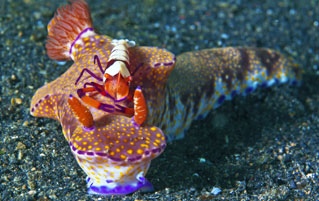5 Animals That Have Learned How to Keep Pets

Keeping a pet is the kind of asshole move that only humans could think up. Taking an otherwise wild creature, slapping a collar on it or sticking it in a cage, and making it dance for our pleasure? That shit would never work in the animal kingdom, where every creature that isn't your own species is either predator or prey.
Yet, looking around this giant waterlogged space-boulder we call Earth, we find several clear cases of domestication among animals that shouldn't even grasp the concept. Fortunately for us, the photos of these creatures together are almost always hilarious.
Giant Tarantulas Employ Tiny Frogs as Housekeepers

It takes a moment for the eye to adjust to that image, because it makes no goddamned sense. That there is a huge, furry spider hanging out with his tiny little frog pal, ready to go on adventures together like they're in some awful direct-to-video Disney movie. But that shit is happening out in nature, right this moment.

"Uh ... It's not what it looks like."
As an aggressive, venomous, and trouser-ruiningly huge tarantula, Xenesthis immanis has no trouble murdering just about anything it wants. Small, furry mammals are nothing more than fast food, and it can even kill and eat venomous snakes simply by biting first. It's pretty much the last animal you'd expect to keep a loving, loyal pet. And yet, Xenesthis immanis has made itself a best friend in the form of a tiny, adorable, dopey-looking frog named Chiasmocleis ventrimaculata.
This frog is so teeny and vulnerable, even Kermit could slap it around. They're aware of this, too, doing just about anything to survive, from living under massive mounds of elephant shit to living under the figurative thumb of an eight-legged murderer.

Keep in mind, they eat other frogs.
The latter is actually the perfect setup, for both frog and spider. As the spider feasts on prey, discarded remains begin to pile up. This (along with the spider's appetizing eggs) attracts ants and other hungry pests, which the tiny amphibian eats up before any damage can be done to the nest. In exchange, the spider does not kill and eat the frog. That's ... pretty much it. These two radically different species have come to an unspoken understanding.

Or maybe a spoken one. We don't speak spider-frog.
Of course, this is a giant, angry, hungry spider, and sometimes they forget themselves. Should Xenesthis ever lose its shit like Oscar Madison on bath salts and start picturing its pet Felix roasted on a plate with an apple in its mouth, the suddenly-not-so-harmless froggy will unveil its secret weapon: toxic skin. Biting into it isn't enough to kill the spider, but will certainly persuade it to cancel its dinner plans and go back to chewing on something safer. Like a cobra.
Emperor Shrimps Ride Other Creatures Like They're Horses

Despite sharing a title with Palpatine, emperor shrimps are actually about as powerful as that little frog thing Jabba was friends with. Tiny, slow, weak, and defenseless, these guys are all but predestined to wind up the main course on some bigger fish's barbie. How do they survive, then? By turning every larger creature they see into their majestic stallion, to carry them along the ocean floor like the freaking Lone Ranger.

"WHEEEE!!"
Emperor shrimps are natural hitchhikers, and they'll ride just about anything in a pinch (they might even choose you, which is certainly a better fate than if a shark decided to do so) -- but their ideal whip is some venomous creature, like a sea cucumber, medusa worm, or nudibranch. Those animals are usually brightly colored, a striking visual that can easily convince potential predators to stay the fuck away or risk a very painful death indeed.
Unlike most other creatures that travel from place to place via living, breathing taxi, these shrimps are not parasites. They don't harm their trusty steeds in any way, and might even help them by nibbling on actual parasites that stupidly try to take root. More often, though, they simply hitch a ride to wherever it is shrimps go when they're not slathered in butter on somebody's plate, feasting on any waste or debris that the steed kicks up during the ride.

"I'm going to call you Falcor."
Emperor shrimps are so dependent on their free rides, in fact, that if they can't get one, they'll just sit around and mope until something sittable comes along. But when one does, the scene's more magical than a hundred "soldiers on leave surprising their children" videos put together. Such as in the video below: If worm whispering isn't your thing, just skip to 5:20 and enjoy the new couple's beautiful first dance together.
Keyhole Limpets Keep Scale Worms Around as Attack Dogs

Keyhole limpets are typical cone-shelled mollusks, in that they don't do a whole lot with their day aside from laying there, sticking to shit, and suffering recurring nightmares about someday being fried and dunked in mayonnaise.

Mmmmm ... limpy.
Their shells offer decent protection from predators, so long as those predators are too stupid to realize that meaty mollusk goodness is but a single flip away. The problem is, they're usually not, and this results in the limpet spending the rest of eternity as starfish poop.
But limpets aren't stupid (well, as not-stupid as a near-brainless organism can be), and many have set up a home defense system to scare off those who might want to eat it. Since their species isn't covered under the Second Amendment, guns are sadly not an option (they have no cold, dead hands from which to pry a rifle anyhow). Their alternate weapon of choice? A big, ugly, pissed-off attack worm.

"I'm standing my ground ... well, ocean floor. You know what I mean."
Known as Arctonoe vittata (which rhymes with "Hakuna matata," in case Weird Al is reading this and needs ideas), this cuddly bit of bait lives inside the limpet's shell, happily eating and napping all day while enjoying the good life. But unlike your lazy, apathetic cat, who clearly takes being a pet for granted, the scale worm is extremely protective of its cozy home. Should some shithead predator attempt to dine on its master, the worm will quickly (and viciously) dissuade it from doing so via a series of ferocious ninja bites.
The biting part could easily be avoided if the limpet would simply stick up a "Beware of Worm" sign somewhere in its territory, but clearly it would rather hand would-be intruders a brutal, toothy surprise. They're assholes like that.

It's basically giving you the finger in this pic.
Meat Ants Wrangle Up Leafhoppers and Drink From Their Asses

As we've hinted at in the past, ants are craven ass fetishists, drinking butt nectar from aphids and other small creatures like some shady director is paying them $500 to do so. But as it turns out, certain ants get way more into the domestication process than others, to the point where their "cattle" literally can't imagine life without them.
This is the meat ant, a vicious and carnivorous breed native to Of Course It's Fucking Australia. They largely feast on the carcasses of dead animals, because they're far less likely to run away in screaming terror than any of us would be. If something comes along that meat ants can't eat, they'll simply outnumber it with sheer pissed-off antness until it gets the points and hauls ass to another time zone. The point is, if these guys approach your pic-a-nic basket, just let them take it. It's safer that way.

"Ambrosia? Gross."
But when it comes to finding something to drink, they're all about milking the living. Their favorite cow is the leafhopper, an insect famous for ... well, hopping. But also for regularly getting wrangled up by the big tough meat ants and harvested for butt residue. The hoppers produce a sweet resin that the ants just adore, both for consumption and for food preservation. In return for the never-ending butt-ffet, the ants offer protection from predators who value the leafhoppers less for their resin and more for their crunchy, yummy bodies.
If need be, the ants will actually carry the leafhopper (or any other sweet-pooping insect it might rustle up with its metaphorical lasso) away to safety so the two can coexist more peacefully.

"I can show you the world. Shining, shimmering, splendid."
The hoppers are so dependent on their masters for survival, they might not even mind the ants turning them into steak once the drink finally runneth dry.
Potter Wasps Have Guard Mites for Their Babies

Potter wasps are terrible abominations of nature, so much so that even other wasps want to harm them. This makes for a hard life, especially when the wasp is trying to be a good parent and not get its kids mutilated or eaten. To protect the little devils (literally -- these are wasps, after all), the parents have enlisted the aid of an unlikely ally: mites.

We'll pause while you scratch.
In general, mites suck. They'll infest anything that can even begin to promise food. In response, potter wasps put the freeloading little bastards to work as babysitters. After being deposited into a wasp's nest, the mites hang around, share the babies' food, and stand guard. Whenever some nasty intruder wasp shows up to wreak havoc in the nursery and redefine "baby food" in the worst possible way, the mites respond by bum-rushing the interloper and biting the ever-loving shit out of it.
The mites don't harm their masters' children and are rewarded for their service with their very own doggy carrying cases -- potter wasps have actually evolved pockets in their bodies, called acarinaria, specifically designed to carry new mites to the nest so that they may get to work.

That's like growing a second set of genitals just for your scabies.
And the wasp moms have to be precise: Too few of the mites, and the attackers will merrily eat the wasp babies. Too many, and the mites will eat all the food and let the children starve to death. Not that we care because, again, fuck wasps.
E. Reid Ross is a columnist at Man Cave Daily. Feel free to follow him on Twitter here.
Related: Curious about just what adorable animals could kick your ass? Check out this Cracked video. And did you know prairie dogs are talking to you personally? It's truly a magical world, and even the most terrifying animals wind up containing some life-saving cure.
